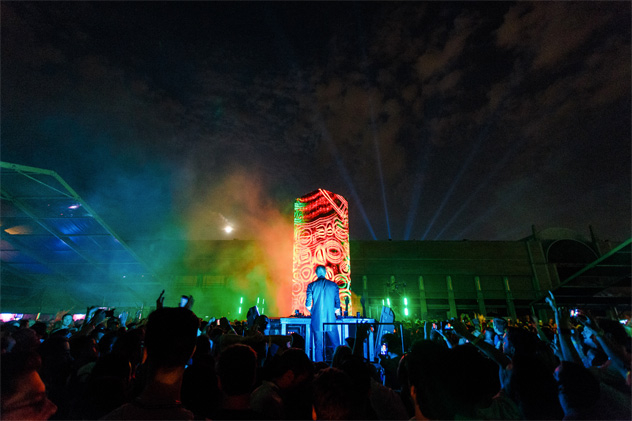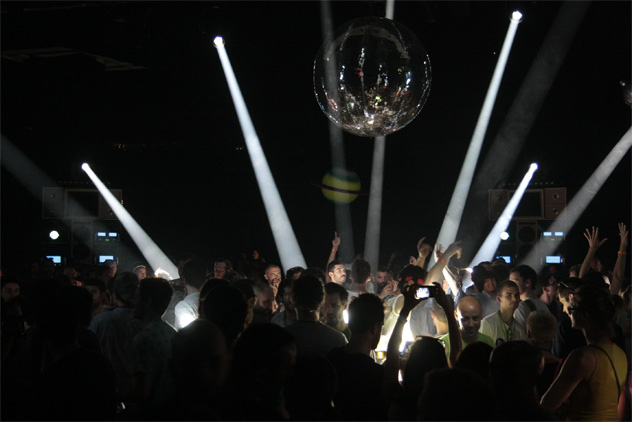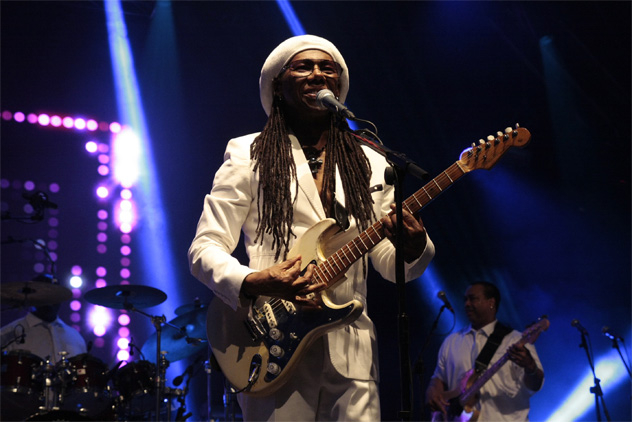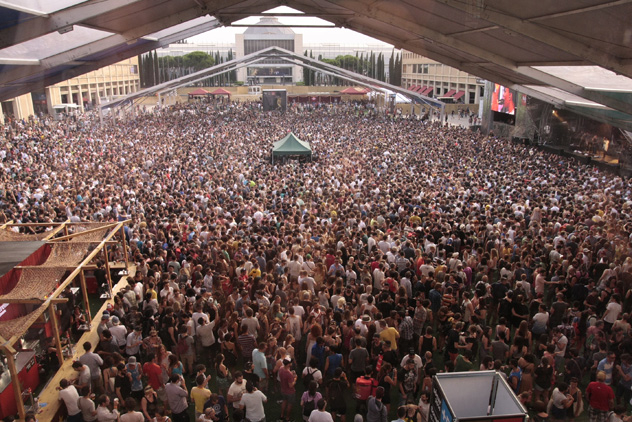- Despite the adventurousness of its bookings and the longevity of its brand, Sónar is most striking for its scale. With huge venues and a seemingly infinite number of artists booked (not to mention an alternate dimension of unaffiliated parties in the city beyond the festival's gates), you're bound to feel like you're missing something. I knew I'd have to make some tough choices about who to see over the festival's three days, but one performance seemed mandatory: Richie Hawtin's Plastikman show, which closed Sónar By Day on Thursday. A jet-black tower (I'm told "cuboid" is the proper terminology) had been erected in the midst of the crowd at the SonarVillage stage at the Fira Barcelona, and as night fell, it started to glow in round, white patches. Hawtin emerged on a gear-laden platform between the cuboid and the main stage, combed his signature blonde coif back with his fingers and began teasing techy acid textures from the soundsystem. The images on the tower grew increasingly intricate as Hawtin's set progressed—laser-green lattices, tangles of iris-burning red—but the music it accompanied burrowed into itself rather without really grabbing the crowd. Were it not for the high-energy opening-night vibe or the sheer spectacle of the cuboid, the set would have been too low-key.
 On Friday, I checked out Sónar By Day's other imposing cuboid, this one built from thick black curtains hung from the middle of an otherwise empty convention hall. Unlike Hawtin's, you could walk inside this one, and as I approached it, I could tell something ridiculously loud was going on inside. This was Despacio, a kind of makeshift nightclub that ran all day for the entirety of the festival. James Murphy and 2ManyDJs are the project's frontmen and selectors, but they'd set up the booth in near-darkness off to the side of the space, turning the lights instead on the formidable soundsystem the event was meant to showcase. Towering speaker stacks, each one boasting some ungodly number of expensive-looking McIntosh amplifiers, formed a ring around a dance floor that bathed a few hundred dancers in warm, clear and punchy sound. Murphy and the Dewaeles were really taking the system for a test drive, playing everything from way-underground house (Marcellis's "Because") to indie-dance classics (Orange Juice's "Rip It Up") to "Here Comes The Sun" by the Beatles, which, it's safe to say, sounded considerably better than anyone in the crowd had ever heard it. The few hours I spent pinned to the dance floor at Despacio were some of the best all weekend. I could have easily spent most of Sónar By Day there, but there was too much else to see.
On Friday, I checked out Sónar By Day's other imposing cuboid, this one built from thick black curtains hung from the middle of an otherwise empty convention hall. Unlike Hawtin's, you could walk inside this one, and as I approached it, I could tell something ridiculously loud was going on inside. This was Despacio, a kind of makeshift nightclub that ran all day for the entirety of the festival. James Murphy and 2ManyDJs are the project's frontmen and selectors, but they'd set up the booth in near-darkness off to the side of the space, turning the lights instead on the formidable soundsystem the event was meant to showcase. Towering speaker stacks, each one boasting some ungodly number of expensive-looking McIntosh amplifiers, formed a ring around a dance floor that bathed a few hundred dancers in warm, clear and punchy sound. Murphy and the Dewaeles were really taking the system for a test drive, playing everything from way-underground house (Marcellis's "Because") to indie-dance classics (Orange Juice's "Rip It Up") to "Here Comes The Sun" by the Beatles, which, it's safe to say, sounded considerably better than anyone in the crowd had ever heard it. The few hours I spent pinned to the dance floor at Despacio were some of the best all weekend. I could have easily spent most of Sónar By Day there, but there was too much else to see.
 Sónar By Day would be a formidable festival in its own right—Theo Parrish and DJ Harvey closed Friday and Saturday in style, with Matmos, Oneohtrix Point Never and James Holden all turning in stellar sets—but Sónar By Night makes it look rather quaint by comparison. Friday night was my first time at the sprawling Fira Gran Via, and I'd been told I'd be overwhelmed by the space. Yet as I took in Moderat, a dot perched a few thousand ravers ahead of me, I couldn't imagine a better place to hear such massive sounds. For better or worse, By Night showcases acts who are completely at home on big stages. DJ sets from Hawtin and Loco Dice, for example, dumbed techno down to its easiest elements, moving hordes from cavernous kick to mammoth breakdown and back again. Nile Rodgers and Chic weren't any less cheesy, really—the world's best rhythm guitar player packed in hit after hit, implored us to clap our hands endlessly and even personally rapped "Rapper's Delight" during a heroic rendition of "Good Times"—but there wasn't a more engaging or skillfully wrought set all weekend. Caribou and James Holden's Saturday night back-to-back set proved you can go big without sacrificing sophistication, rolling out unpeggable tunes as broadly appealing as they were deeply weird.
Sónar By Day would be a formidable festival in its own right—Theo Parrish and DJ Harvey closed Friday and Saturday in style, with Matmos, Oneohtrix Point Never and James Holden all turning in stellar sets—but Sónar By Night makes it look rather quaint by comparison. Friday night was my first time at the sprawling Fira Gran Via, and I'd been told I'd be overwhelmed by the space. Yet as I took in Moderat, a dot perched a few thousand ravers ahead of me, I couldn't imagine a better place to hear such massive sounds. For better or worse, By Night showcases acts who are completely at home on big stages. DJ sets from Hawtin and Loco Dice, for example, dumbed techno down to its easiest elements, moving hordes from cavernous kick to mammoth breakdown and back again. Nile Rodgers and Chic weren't any less cheesy, really—the world's best rhythm guitar player packed in hit after hit, implored us to clap our hands endlessly and even personally rapped "Rapper's Delight" during a heroic rendition of "Good Times"—but there wasn't a more engaging or skillfully wrought set all weekend. Caribou and James Holden's Saturday night back-to-back set proved you can go big without sacrificing sophistication, rolling out unpeggable tunes as broadly appealing as they were deeply weird.
 Sónar is pretty fearless about who it'll put on an enormous stage, so it isn't surprising that its scheduling occasionally fell flat. Todd Terje certainly sounded the part during his By Night live set—aside from Chic, no one played more joyous tunes anywhere in Barcelona that weekend—but he lacked the stage presence or visual show to really pull off a venue that size. Edgy music at By Night worked best at SonarCar, the smallest stage and, with a Void system instead of the typical festival line array, by far the best sounding. Sandwiched between the gigantic SonarLab and SonarPub arenas and stationed in front of a bumper car track, this stage drew inconsistent numbers over the festival's two nights; sometimes it was as packed as the larger stages (as it was for the Spanish DJ Uner on Saturday), and at others it felt like a very loud hallway. Artists made the most of it in either case. Visionist and Happa provided a dark, dank introduction to L.I.E.S. acts Ron Morelli and Svengalisghost, who dared passersby to proceed to one of the larger stages. (The latter's live set, more punk than house, was as sonically extreme as it was catchy and appealing.) Kuduro luminary DJ Nigga Fox seemed to be plagued by technical issues, but his signature sound didn't suffer too much—bouncy, abstract, rough-hewn yet futuristic, it stopped me dead in my tracks as I wandered from Caribou and James Holden to the food court.
Sónar is pretty fearless about who it'll put on an enormous stage, so it isn't surprising that its scheduling occasionally fell flat. Todd Terje certainly sounded the part during his By Night live set—aside from Chic, no one played more joyous tunes anywhere in Barcelona that weekend—but he lacked the stage presence or visual show to really pull off a venue that size. Edgy music at By Night worked best at SonarCar, the smallest stage and, with a Void system instead of the typical festival line array, by far the best sounding. Sandwiched between the gigantic SonarLab and SonarPub arenas and stationed in front of a bumper car track, this stage drew inconsistent numbers over the festival's two nights; sometimes it was as packed as the larger stages (as it was for the Spanish DJ Uner on Saturday), and at others it felt like a very loud hallway. Artists made the most of it in either case. Visionist and Happa provided a dark, dank introduction to L.I.E.S. acts Ron Morelli and Svengalisghost, who dared passersby to proceed to one of the larger stages. (The latter's live set, more punk than house, was as sonically extreme as it was catchy and appealing.) Kuduro luminary DJ Nigga Fox seemed to be plagued by technical issues, but his signature sound didn't suffer too much—bouncy, abstract, rough-hewn yet futuristic, it stopped me dead in my tracks as I wandered from Caribou and James Holden to the food court.
 It's possible Sónar was both better and worse than I found it to be. Had I tweaked my itinerary slightly, I might have been convinced it was purely a festival for stadium techno, profoundly experimental music or new technology. (A tech showcase called +D occupied a few rooms of By Day, housing hacklabs, conference-style presentations and prototypes of things like laser-controlled synthesizers.) With a little pre-planning, a download of the schedule to your iPhone and a fair amount of festival endurance, Sónar is still one of the best weekends for electronic music in Europe, where rave occasionally becomes something like high art.
Photo credits: Guillermo Granell (Despacio, Nile Rodgers, By Day crowd)
It's possible Sónar was both better and worse than I found it to be. Had I tweaked my itinerary slightly, I might have been convinced it was purely a festival for stadium techno, profoundly experimental music or new technology. (A tech showcase called +D occupied a few rooms of By Day, housing hacklabs, conference-style presentations and prototypes of things like laser-controlled synthesizers.) With a little pre-planning, a download of the schedule to your iPhone and a fair amount of festival endurance, Sónar is still one of the best weekends for electronic music in Europe, where rave occasionally becomes something like high art.
Photo credits: Guillermo Granell (Despacio, Nile Rodgers, By Day crowd)
 On Friday, I checked out Sónar By Day's other imposing cuboid, this one built from thick black curtains hung from the middle of an otherwise empty convention hall. Unlike Hawtin's, you could walk inside this one, and as I approached it, I could tell something ridiculously loud was going on inside. This was Despacio, a kind of makeshift nightclub that ran all day for the entirety of the festival. James Murphy and 2ManyDJs are the project's frontmen and selectors, but they'd set up the booth in near-darkness off to the side of the space, turning the lights instead on the formidable soundsystem the event was meant to showcase. Towering speaker stacks, each one boasting some ungodly number of expensive-looking McIntosh amplifiers, formed a ring around a dance floor that bathed a few hundred dancers in warm, clear and punchy sound. Murphy and the Dewaeles were really taking the system for a test drive, playing everything from way-underground house (Marcellis's "Because") to indie-dance classics (Orange Juice's "Rip It Up") to "Here Comes The Sun" by the Beatles, which, it's safe to say, sounded considerably better than anyone in the crowd had ever heard it. The few hours I spent pinned to the dance floor at Despacio were some of the best all weekend. I could have easily spent most of Sónar By Day there, but there was too much else to see.
On Friday, I checked out Sónar By Day's other imposing cuboid, this one built from thick black curtains hung from the middle of an otherwise empty convention hall. Unlike Hawtin's, you could walk inside this one, and as I approached it, I could tell something ridiculously loud was going on inside. This was Despacio, a kind of makeshift nightclub that ran all day for the entirety of the festival. James Murphy and 2ManyDJs are the project's frontmen and selectors, but they'd set up the booth in near-darkness off to the side of the space, turning the lights instead on the formidable soundsystem the event was meant to showcase. Towering speaker stacks, each one boasting some ungodly number of expensive-looking McIntosh amplifiers, formed a ring around a dance floor that bathed a few hundred dancers in warm, clear and punchy sound. Murphy and the Dewaeles were really taking the system for a test drive, playing everything from way-underground house (Marcellis's "Because") to indie-dance classics (Orange Juice's "Rip It Up") to "Here Comes The Sun" by the Beatles, which, it's safe to say, sounded considerably better than anyone in the crowd had ever heard it. The few hours I spent pinned to the dance floor at Despacio were some of the best all weekend. I could have easily spent most of Sónar By Day there, but there was too much else to see.
 Sónar By Day would be a formidable festival in its own right—Theo Parrish and DJ Harvey closed Friday and Saturday in style, with Matmos, Oneohtrix Point Never and James Holden all turning in stellar sets—but Sónar By Night makes it look rather quaint by comparison. Friday night was my first time at the sprawling Fira Gran Via, and I'd been told I'd be overwhelmed by the space. Yet as I took in Moderat, a dot perched a few thousand ravers ahead of me, I couldn't imagine a better place to hear such massive sounds. For better or worse, By Night showcases acts who are completely at home on big stages. DJ sets from Hawtin and Loco Dice, for example, dumbed techno down to its easiest elements, moving hordes from cavernous kick to mammoth breakdown and back again. Nile Rodgers and Chic weren't any less cheesy, really—the world's best rhythm guitar player packed in hit after hit, implored us to clap our hands endlessly and even personally rapped "Rapper's Delight" during a heroic rendition of "Good Times"—but there wasn't a more engaging or skillfully wrought set all weekend. Caribou and James Holden's Saturday night back-to-back set proved you can go big without sacrificing sophistication, rolling out unpeggable tunes as broadly appealing as they were deeply weird.
Sónar By Day would be a formidable festival in its own right—Theo Parrish and DJ Harvey closed Friday and Saturday in style, with Matmos, Oneohtrix Point Never and James Holden all turning in stellar sets—but Sónar By Night makes it look rather quaint by comparison. Friday night was my first time at the sprawling Fira Gran Via, and I'd been told I'd be overwhelmed by the space. Yet as I took in Moderat, a dot perched a few thousand ravers ahead of me, I couldn't imagine a better place to hear such massive sounds. For better or worse, By Night showcases acts who are completely at home on big stages. DJ sets from Hawtin and Loco Dice, for example, dumbed techno down to its easiest elements, moving hordes from cavernous kick to mammoth breakdown and back again. Nile Rodgers and Chic weren't any less cheesy, really—the world's best rhythm guitar player packed in hit after hit, implored us to clap our hands endlessly and even personally rapped "Rapper's Delight" during a heroic rendition of "Good Times"—but there wasn't a more engaging or skillfully wrought set all weekend. Caribou and James Holden's Saturday night back-to-back set proved you can go big without sacrificing sophistication, rolling out unpeggable tunes as broadly appealing as they were deeply weird.
 Sónar is pretty fearless about who it'll put on an enormous stage, so it isn't surprising that its scheduling occasionally fell flat. Todd Terje certainly sounded the part during his By Night live set—aside from Chic, no one played more joyous tunes anywhere in Barcelona that weekend—but he lacked the stage presence or visual show to really pull off a venue that size. Edgy music at By Night worked best at SonarCar, the smallest stage and, with a Void system instead of the typical festival line array, by far the best sounding. Sandwiched between the gigantic SonarLab and SonarPub arenas and stationed in front of a bumper car track, this stage drew inconsistent numbers over the festival's two nights; sometimes it was as packed as the larger stages (as it was for the Spanish DJ Uner on Saturday), and at others it felt like a very loud hallway. Artists made the most of it in either case. Visionist and Happa provided a dark, dank introduction to L.I.E.S. acts Ron Morelli and Svengalisghost, who dared passersby to proceed to one of the larger stages. (The latter's live set, more punk than house, was as sonically extreme as it was catchy and appealing.) Kuduro luminary DJ Nigga Fox seemed to be plagued by technical issues, but his signature sound didn't suffer too much—bouncy, abstract, rough-hewn yet futuristic, it stopped me dead in my tracks as I wandered from Caribou and James Holden to the food court.
Sónar is pretty fearless about who it'll put on an enormous stage, so it isn't surprising that its scheduling occasionally fell flat. Todd Terje certainly sounded the part during his By Night live set—aside from Chic, no one played more joyous tunes anywhere in Barcelona that weekend—but he lacked the stage presence or visual show to really pull off a venue that size. Edgy music at By Night worked best at SonarCar, the smallest stage and, with a Void system instead of the typical festival line array, by far the best sounding. Sandwiched between the gigantic SonarLab and SonarPub arenas and stationed in front of a bumper car track, this stage drew inconsistent numbers over the festival's two nights; sometimes it was as packed as the larger stages (as it was for the Spanish DJ Uner on Saturday), and at others it felt like a very loud hallway. Artists made the most of it in either case. Visionist and Happa provided a dark, dank introduction to L.I.E.S. acts Ron Morelli and Svengalisghost, who dared passersby to proceed to one of the larger stages. (The latter's live set, more punk than house, was as sonically extreme as it was catchy and appealing.) Kuduro luminary DJ Nigga Fox seemed to be plagued by technical issues, but his signature sound didn't suffer too much—bouncy, abstract, rough-hewn yet futuristic, it stopped me dead in my tracks as I wandered from Caribou and James Holden to the food court.
 It's possible Sónar was both better and worse than I found it to be. Had I tweaked my itinerary slightly, I might have been convinced it was purely a festival for stadium techno, profoundly experimental music or new technology. (A tech showcase called +D occupied a few rooms of By Day, housing hacklabs, conference-style presentations and prototypes of things like laser-controlled synthesizers.) With a little pre-planning, a download of the schedule to your iPhone and a fair amount of festival endurance, Sónar is still one of the best weekends for electronic music in Europe, where rave occasionally becomes something like high art.
Photo credits: Guillermo Granell (Despacio, Nile Rodgers, By Day crowd)
It's possible Sónar was both better and worse than I found it to be. Had I tweaked my itinerary slightly, I might have been convinced it was purely a festival for stadium techno, profoundly experimental music or new technology. (A tech showcase called +D occupied a few rooms of By Day, housing hacklabs, conference-style presentations and prototypes of things like laser-controlled synthesizers.) With a little pre-planning, a download of the schedule to your iPhone and a fair amount of festival endurance, Sónar is still one of the best weekends for electronic music in Europe, where rave occasionally becomes something like high art.
Photo credits: Guillermo Granell (Despacio, Nile Rodgers, By Day crowd)